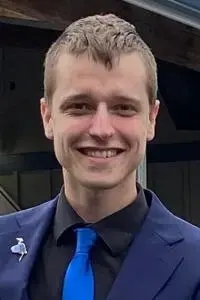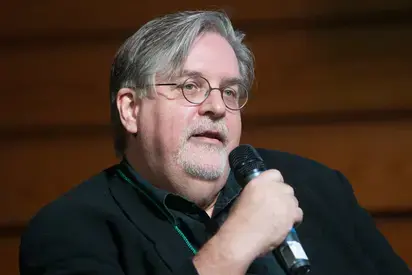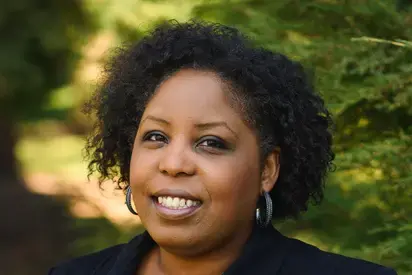
Alumni Programs is denoted as AP and Mason Rolph is denoted as MR in this interview.
We sat down with Olympia Community Solar president and outdoor enthusiast, Mason Rolph, to learn more about his journey at Evergreen and how his team is bringing community solar to the forefront in the clean energy transition.
AP: Tell us about yourself, who is Mason Rolph?
MR: Hi, my name is Mason, I use he/him pronouns, I was class of 2017 and I describe myself as a climate and clean energy activist. During my time at Evergreen, I was a student organizer of TOP (The Outdoor Program), that’s a big part of who I am, spending time outdoors climbing, backpacking. I really love the closest part of the Olympic Mountains near Olympia, Mt. Elinor, Mt. Washington, Lake Cushman, and Capitol Forest are my favorites for hiking and climbing. I also love Evergreen’s forest, Evergreen has the prettiest woods around and running into current students is always fun.
AP: What brought you to Evergreen?
MR: The thing that convinced me to attend Evergreen was my first campus visit, even before I parked my car I was convinced. Seeing the canopy of the trees along the parkway grabbed my heart. The academic programming and the freedom to choose and change what I was studying was a huge attraction.
I originally came to Evergreen with a mindset that I needed to learn climate adaptation skills to live and survive in an adverse climate and the challenges that come along with climate breakdown. So, I started learning how to grow and create my own food and medicine, and I took wood and metal shop programs. Throughout my time at Evergreen my mindset shifted from seeing climate change as a future threat to something that is immediate and needs to be mitigated right now, and that changed the shape of my learning. You often hear terms like adaptation vs. mitigation when it comes to climate change and it's important to know the difference. Adaptation is shifting one’s own lifestyle to learn to live in a world that is impacted by climate change, for example, preparing for wildfires or sea level rise. Mitigation on the other hand is actively stopping what is causing those changes in the first place.
AP: Were there any classes or faculty that inspired you while at Evergreen?
MR: Heck yeah! All of them!
I loved everyone I worked with. I specifically would say the organic farming program with Paul Przybylowicz and David Muhleisen impacted me. Zoltan Grossman as well, though I never took a program with him, I see him at every single social justice event in town and have a lot of respect for him. The other group who inspired me is all of the students that engaged in the 2017 campus revolt/social justice movement. I am still inspired by all of them. They stood up against someone in a position of power and protected student housing from violent external threats.
AP: Can you tell us more about your non-profit and role working as president for Olympia Community Solar?
MR: Yeah! Olympia Community Solar started in 2019. A group of my friends and I were advocating for a ballot initiative in the 2018 election to create a fee on big polluters. Fossil fuel companies spent close to $27 million to defeat it, a record election spending for the state. We came together after that defeat and created a team consisting of Evergreen alumni, some of whom worked on the Evergreen Tacoma solar project, and we talked about solutions locally. We had frustrations about the slow movement of top-down climate policy and legislation in Washington State, and thought we had a better chance of making change through local community projects.
Olympia Community Solar’s mission statement is to steward an equitable and accessible transition to clean energy. Over the past 4 years we’ve been organizing clean energy projects that benefit communities who have been left out of the clean energy transition.
We have several programs! The Solarize campaign is a community-driven initiative aimed at making it easier and more affordable for homeowners and businesses to go solar. Through the campaign we provide educational resources, one-on-one consultations, and group purchasing discounts to help participants navigate the solar installation process and take advantage of cost savings. By leveraging the power of community buying, we hope to accelerate the adoption of solar energy and promote a more sustainable future for all. The program is currently open for residents of Thurston, Mason, and Skagit Counties at olysol.org/solarize.
Another program we offer is community solar. Community solar allows a group of people to share ownership of a solar project. Our nonprofit develops projects, runs capital campaigns to raise funds, and manages the system on behalf of the participants. We crowdfund the installation costs and then use the energy generation to return the participant’s funds to them. We have two projects already installed and operating at the Children’s Museum and on the Olympia Farmers Market in downtown Olympia. We are currently enrolling participants in a community solar project on a local middle school. There will be 200 solar panels on the school and people have the choice to purchase or donate a subscription for a solar panel. Anybody may purchase or donate subscriptions on the project’s webpage, olysol.org/projects/tmcs.
In addition to community solar projects, we also provide technical support and grant writing to organizations trying to install solar, such as non-profits, tribes, and public entities. We have been highly successful in our local projects, usually covering 100% of the costs of installing solar. For example, we worked on Quixote Village, a tiny home village for formerly houseless folks in Olympia, and that system is gorgeous, we have panels on all 30 tiny homes! We worked on funding over 300 solar panels on Merritt Manor, a low-income housing complex housing 82 families, providing energy savings to that community. We also have worked with the Nisqually Tribe to install solar on their business headquarters, and it was the first commercial solar project on the Nisqually reservation.
AP: What is the biggest challenge that people or organizations that try to install solar face?
MR: I would say the first biggest challenge is lack of understanding. If you want to install solar on your home, you need to navigate finding a contractor and securing a proposal. The complexity is why we created our Solarize campaign – to simplify the process and guarantee customers that their contractor is reputable. But Solarize does not address all the barriers.
Most people can’t access rooftop solar. One way I demonstrate this at an event, panel, or presentation is to ask people there if they can raise their hand, if they can, and to keep it raised ‘if you own a home or building,’ 60% of hands come down. Then I ask again ‘keep your hand up if your house has good solar exposure,’ more hands come down; then I ask if their roof is in good condition, more hands come down. By the end usually one in ten hands are still raised – and that’s not even considering financial barriers!
These barriers are why community solar is so important, it expands access to renters, homes in the woods, multifamily housing, and most folks that can’t afford their own solar installation.
AP: Can you share some of the reasons people install solar?
MR: The biggest reason I run into is economic benefit. Solar is an investment, but once installed it is extremely reliable at producing long term energy savings. That long term benefit creates independence. When folks invest in solar it frees them of the volatile price changes in the energy market. In the last few years, we have seen some huge changes in energy prices. If you have a solar project on your roof, it is freedom from the rising utility rates.
To understand the economic benefits solar could have for your home, seek assessments and quotes from reputable local contractors or sign up for our Solarize Campaign.
AP: Who opened doors for you?
MR: Two people come to mind! Jeff Cramer and Kirk Haffner.
When I graduated, I was adrift looking for a job opportunity and Jeff helped create an internship position at a community solar trade association. The position was my foot-in-the-door moment in the industry.
When we started Olympia Community Solar, Kirk Haffner who is the owner of South Sound Solar, supported me. He introduced me to the Children’s Museum, where we now have a project installed, and taught us how to develop solar projects. He is a particularly good teacher, mentor, and continues to support me!
AP: What impact do you hope to make through Olympia Community Solar?
MR: I hope to engage in clean the energy transition in a way that shifts power and energy ownership to average people, practically those who have been historically left out of the opportunity. Once the clean energy transition happens the big question is will it be people owned or utility owned and sold to people? I am focusing on getting ownership into the hands of people.
I want to reduce people's energy burdens so they can spend their money on other things, like building their families and lives. Energy burden is the percentage of your income that goes to energy costs. If you make a high salary, you may only have to spend 2% of your monthly income on energy costs, whereas someone who has a low salary will spend closer to 9-15% of their monthly income on energy. That imbalance is detrimental, and it continues to exacerbate inequity and perpetuate barriers to access clean energy and independence.
AP: What advice would you give current students studying at Evergreen today who will join you as alumni?
MR: The two most valuable skills I learned at Evergreen were how to do self-directed study and how to learn new things, how to be a student. Regardless of what I am working on, if I can self-direct and learn new skills then I can do anything! They are so valuable and Evergreen forces you to learn them because of the self-directed study and pathways.
The other piece of advice is the solar energy industry is hiring, so if you are graduating and looking for a job, we will hire you! We need more workers in this industry!
AP: What is your superpower?
MR: As it relates to Olympia Community Solar, I would say my superpower is breaking very big things into small, manageable steps. A quarter-million dollar infrastructure project is overwhelming, but I know how to approach it in a methodical manner. This week we identify the site, next week we ask solar installers for proposals. Keep the steps small, and if I miss one, the fall is also small. By completing lots of small steps, suddenly we’re at the top of the mountain, and getting ready to cut the project’s ribbon!
This mentality has helped me take on projects that seemed impossible before.






